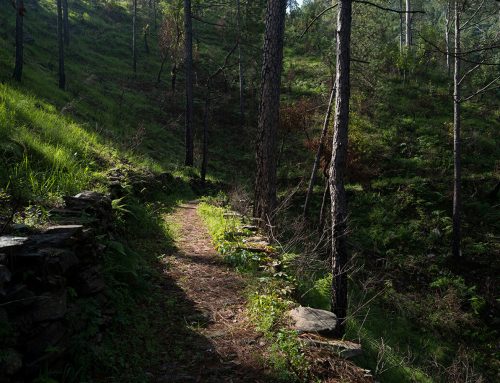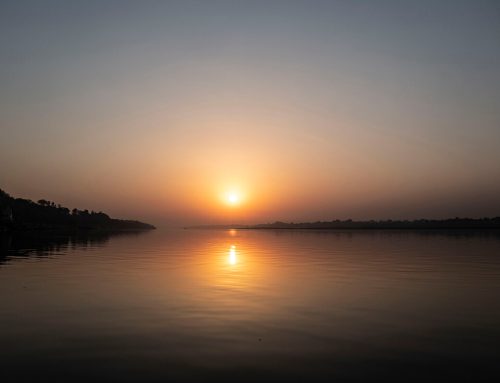E A R T H
A visit to the Awadhoot Kinaram Ashram, the seat of the Aghoris.

Varanasi, India
Every major sacred site in India exists in Varanasi, not just in the mystical sense, but there are exact scaled-down versions of original temples here. People believe that if you come to Varanasi, you can forego all other spiritual wanderings. We follow Umesh through the narrow lanes behind the ghats packed with ancient temples. I attend numerous pujas, am blessed and blessed again, and steal glimpses of the residing deities, their fierce eyes staring out from bodies swathed in exquisite fabrics. Some of the temples are quiet and a kind of solitude descends. In the more popular ones, we are continuously immersed in throngs of barefoot devotees, pushed and shoved in a heaving line leading to the inner sanctum, everyone eager to be blessed by the priest and get a glimpse of Shiva, Vishnu, Ganesh, Hanuman, Kali or Durga. It’s a total sensory experience with temple bells ringing, the Hanuman Chalisa is chanted live in the corner, a pungent aroma of incense and fragrant flowers is ever present, mantras float through the air, and children run and scream with excitement. I get the sense that for Indians these temple visits are a kind of pure theatre and intense socialization, a welcome opportunity to get outside of the rigid routine of their lives. There is a tangible dimension of energy here, yet often it seems laced with a kind of desperation or grasping that comes from the belief that the gods will sort out the problems in their life. But, I understand very little. The intensity makes me crave the serene solitude of sacred Buddhist sites high in the Himalayas. But I’m here and try to embrace the chaos, or withdraw to the sidelines where I can simply sit and observe.

Varanasi, India

The Luminous City
On every other corner is a small shrine with a Shiva lingam, set in a marble surround, with men huddled on all four sides chanting in unison and paying homage to the phallic symbol. This shapeless form of Shiva exists in thousands, as does Nandi the Bull vehicle that is the doorkeeper of Shiva’s temples.

Varanasi, India

Varanasi, India

Varanasi, India
There are curious anthropomorphic murtis (statues) of Hanuman or Ganesh, represented with unworked ‘natural’ stones covered over with red cloth and with orange paint mixed with ghee. There is so much outpouring of love between the deity and the devotee. I’m deeply fascinated by this ancient ritual of darshan and want to ‘see’ and ‘be seen’ by the deity. I want to experience the transcendental power that will reveal my own inner guru. In the past, a few deities have taken hold of me, but much of the time my rational mind reveals only a strange and scary looking creature and I recede respectfully opening the space to others. Perhaps it’s because I’m not Hindu, nor have I been brought up with these deities, so as much as I try to shed my conditioned existential views towards religion and summon up the infinite devotion I often feel in nature, meditation and yoga, I rarely feel a genuine outpouring of love for them. The tantric Vajrayana practice has taught me to see the outer deity only as a tool to train my mind to see its own innate essence. Unlike Hindus, I don’t believe that these gods actually exist. Still, my heart is touched by the strong energy that exists in place where millions of people have walked and shared a similar intention of thought, or prayers, for the benefit of all living beings.

Varanasi, India

Varanasi, India

Varanasi, India
A mysterious site stirs my imagination. Lolark Kund is an ancient Solar-Shaivite site of worship, first mentioned in the Rig Veda (4 C BCE). Three colossal staircases descend steeply, 15 m below street level, to a sacred well in the shape of a keyhole. Lolark means ‘trembling sun’ and at different times during the day, the wavering face of Lord Surya (the Sun God), is reflected in the water as pure light. It’s the most southern of the 12 sun shrines along the Ganga at Varanasi, and each of the shrines mark the exact spot of the cusp between one zodiacal sign and the next. Recent observations have shown the siting to be absolutely correct. I feel a deep reverence for nature here, and am in awe of the ingenious design of the ancients that reveals the path of the sun throughout the year, as well with astronomical events such as total solar eclipse and meteor showers.
I notice that despite being a Brahmin, Umesh rarely takes puja or enters the inner sanctums. I ask him why and he says he only worships Durga after his bi-annual fast, or its too intense, and can actually be destructive. I think of all the blessings I’ve received and feel as if I might dissolve. The temple where he does worship daily is the Aghori Ashram and, to our surprise, it turns out that our Brahmin guide is a plain-clothed tantric aghori.

Varanasi, India

Varanasi, India
The Awadhoot Kinaram Ashram (the seat of the Aghoris in Kashi) is an imposing place surrounded in a red and white striped wall is crowned with tridents that look like a vandalism deterrent. At the entrance are three skulls skewered on a trident, symbolizing Brahma, Shiva and Vishnu as one being. On the top of the gate sits a large lotus flower. Aghoris are a Shaivite Hindu sect believed to have split off from the tantric Kapilaka order that dates back to 1000 BCE. It’s mostly comprised of ascetic sadhus, but here in Varanasi, the ashram is filled with seemingly normal people. ‘A’ means ‘not’ and ‘ghor’ means ‘awful, difficult’. So, Aghor is the easy path – a natural and spontaneous state of consciousness. It’s not a cult or a religion. It’s a state of reality you can experience in any tradition or ideology. Aghor is an ancient spiritual discipline that removes feelings of fear, hatred, disgust or discrimination. It’s the path of utter love and devotion.
Of course, you wouldn’t think this to look at them. In fact, most people find them repulsive and quite terrifying. The most serious aghoris live in the charnel grounds, dress in rags, smear white cremation ash on their body and dreadlocks to look like Shiva, cook their food on the cremation pyres use skulls as their eating bowl and sleep on graves. Sometimes, in rituals they even eat the brains and flesh of rotting corpses. What they are really doing is trying to overcome their own feelings of disgust and embrace everything as a pure and divine emanation of Shiva (pure consciousness). Our fear of death holds a great amount of energy and the best way to overcome it is to confront it. Then we realise that we’re not the ‘body,’ but pure consciousness. If we look inside our mind we see that fear is just a concept. Fear is not real. The more we detest something, have aversions to things, the more energy we invest into it and the worse it becomes. Aghor teaches that if we can remove our judgments, opinions, and the stain of our ‘view,’ we can dissolve these imaginary borders and feel divinity in all things. A big part of being an Aghori is embracing the outcast – the lepers, prostitutes, widows, the destitute, and all those scorned by regular society. They’re renowned for their compassion and charity work in areas that the rest of society distains.
We enter through the imposing gate that leads through large grounds to the main temple. The samadhis (graves) of the 16 previous Aghori babas flank the circumference. They all sit in padmasana (lotus pose), with the left leg in first indicating the tantric path, and are yogins who chose the moment of their passing. The actual body is inside a statue of remarkable likeness. An Aghori priest blesses me, dabs red tika paint between my eyebrows, and gives me prasad. Unlike most temples, where flowers and bananas are given, here we get cremation ash from the wood at Manikarnika Ghat. I approach the dhuni (sacred fire) that has burned continuously for 400 years, cleanse my body with smoke, and turn three times in an anti-clockwise direction. I then sit down and eat my Prasad. It tastes like ash and coats the inside of my mouth. I like the taste of charcoal and this is not much different. I believe it’s pure, divinely blessed, and will not harm me. Perhaps because there are so few people here on this particular evening, or the strange energy of the place, I fall into deep mediation. There is something strangely comforting here.
Behind the temple is a curious tank and in the darkness it looks ominous. Large black pre-historic looking fish swim in the greenish black water that is legendary for its medicinal powers and the healing of lepers. I gingerly step into the tank up to my thighs and feel the cold sensation of the water on my skin. It feels unbelievably silky and smooth, like velvet, and has a magnetic power that draws me deeper. I feel thousands of years of devotion, prayer and love that have been poured into the river.
“There is an indefinable mysterious power that pervades everything. I feel it although I don’t see it. It is this unseen power that makes itself felt, yet defies all proof. It transcends the senses. Everything around me is ever changing, ever dying … underlying all that change is a living power that is changeless, that holds all together, that creates, dissolves and recreates.” – Gandhi
Suddenly, Umesh announces that the Baba will see us. I enter a small room where a very large Aghori is lying sprawled on a bed. He is unwell. These audiences are becoming scarcer. I sit down on the floor very close to him and his enormous smiling face is close to mine. I see the effort required to lift his head. Instead of asking him questions, I simply hold his hand and feel a genuine outpouring of love for him. For a second, I worry that this might not be an appropriate action, hoping that my touch will not pollute a holy being, but instantly it feels right. Perhaps it’s the magic of the Ganga water, but a tremendous compassion rises up in me and my heart opens. I feel pure grace. In retrospect, I think this was a kind of darshan, or direct transmission, where he shared the essence of the Aghori path with me – kindness – where all spiritual paths aim to dissolve boundaries between people allowing for spontaneous connection and a recognition that we are really all one. Walking back to the hotel I feel I’m lighter than air, as if I’m floating on new Ganga legs.

Aghori, Varanasi, Indi
Continued in Part Five: E T H E R >
Heather Elton is a yogini, writer and photographer living in London.





